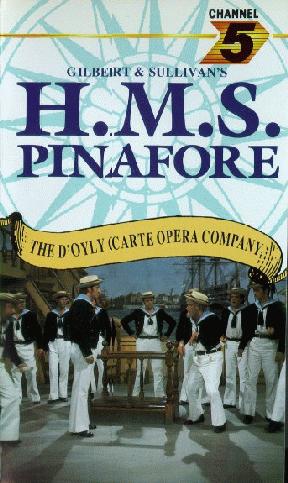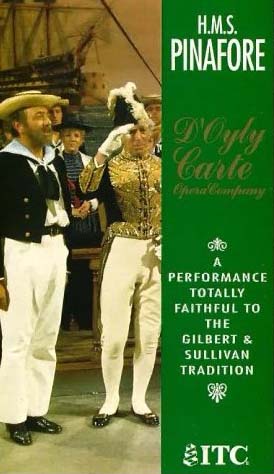The 1973 D'Oyly Carte Pinafore Video
D'Oyly Carte Opera Company
Recorded at the ATV Elstree Studio
First broadcast on ITV |
|
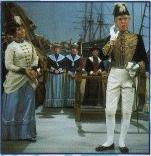 Pauline Wales & John Reed |
This video marked only the third time that the D'Oyly Carte had recorded or filmed one of its productions complete (see the 1965 Patience and 1966 Mikado). At the time this was made, The Savoyard reported that an agreement had been reached with Associated Television to record all the operas, with H.M.S. Pinafore being first. There was no further mention of the deal, which apparently fell through.
The production was originally made to be shown on television and, in that venue, was cut to about an hour in length. In the United States, it was shown on CBS the day after Thanksgiving in 1973, with commentary by Richard Thomas added.
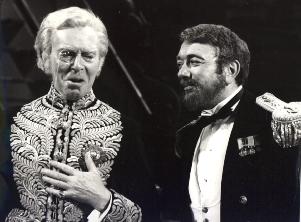 John Reed & Michael Rayner |
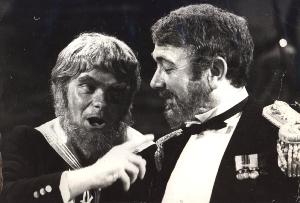 John Ayldon & Michael Rayner (Collection of Michael Rayner) |
A nearly complete (92 minutes) home video version exists, lacking only the overture. It includes encores for "I am the Captain of the Pinafore" and the Bell trio (all five traditional encores are included). However, The condensed version was also issued on home video—see below.
The condensed version was not an edit of the full version, but includes condensed scenes that were performed and recorded that way. Phil Sternenberg observes (and Michael Rayner confirmed—see below), "There are many places where no changes in camera angle occur when lines are missing, and the singers move in a continuous motion that must have been recorded in 'real time.'"
Michael Rayner, who played Captain Corcoran, contributed from his collection two B&W publicity photos taken by ATV's official photographer. Rayner's comments on the video are at the bottom of this page. Rayner also observed, "I think that this was the first time that CC appeared with a beard. It became standard after the filming, and I wore it throughout my stint as the Captain."
J. Donald Smith contributed this review:
Despite the fact that the music is very brisk, the performance exemplifies everything that was going wrong with the D'Oyly Carte and would eventually lead to its closure. The production is traditional, but there is almost a total lack of the performers becoming their characters, with the exception of Michael Rayner as Captain Corcoran. They do all the movements, say all the lines (although there is some sloppiness in word substitution) but there is no sense of conviction. There is a feeling that the performers were self-conscious before the camera.
The inclusion of encores in this context makes no sense. There is applause and laughter, but the sameness and the timing suggest that the audience was canned and added in after the taping. The recording is valuable as a historical relic, but this is not the way to do Pinafore.
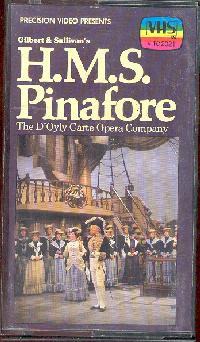 Precision Video VITC2021 |
Bruce Miller, after reading the above, had some additional comments:
It appears to me that they were trying to reproduce, as authentically as possible, Gilbert's original staging. They probably erred to some extent, because research since 1973 has certainly advanced considerably. But I do agree with Don that the effect is stilted to a large degree, despite whatever their relatively new director at the time, Michael Heyland, was able to do to waken it up.
I saw their Pinafore at the New York City Center in November 1967, and although the encores were identical (a few minor bits of business aside), the production that evening did not strike me as so preserved in amber as this video does. John Reed was in the cast but most of the rest were different, and Isidore Godfrey was in the pit. I would suspect the company in 1973 was demoralized to some extent, and that this was the result of the change in both stage and music directors.
The packaging of Bruce's copy (Channel 5 video) indicates that it is 78 minutes long, but in fact, both Don and Bruce timed their copies, and they are 92 minutes, plus or minus a few seconds. The video as packaged for the home market seems to be designed for television, with built-in commercial breaks between the acts, and after the Bell Trio.
The 1981 Magnetic Video issue, is stated to be 66 minutes on the box, and is in fact. To get it down to this length, most of the dialogue scenes are abridged, most of the recitatives are chopped down or eliminated, and many songs lose a verse or two. I agree with Phil Sternenberg (above) that the scenes must have been filmed two ways, because the cuts to the text occur without any visual break.
Two songs are eliminated entirely: "Fair moon" and "Things are seldom what they seem". The most awkward cut is in Josephine's Act II scena, where the abridged version jumps into the middle of the number. This is the one musical cut that may not have been planned during the filming, as it is so inelegant.
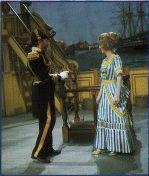 Michael Rayner & Pamela Field |
Most irritatingly, all five encores of the Bell Trio are present. One could question whether the encores belonged in a filmed version at all, but it was at least a faithful document of what D'Oyly Carte did on stage. But, to include all those encores in an abridged version while cutting so much else of the score is really a travesty.
The film has a level of precision that one would expect from D'Oyly Carte, and the musical values are generally very fine. But, the production seems flat, with many of the principals appearing to just go through the motions (even Michael Rayner, in my view, not withstanding Don Smith's comment). You would have to assume that the Company were at least somewhat on their best behavior for the cameras, so the typical performance on tour was probably a lot more dire than this.
There was considerable discussion on SavoyNet about the fact that the laughter seemed "canned," yet there apparently was an invited audience. Leon Berger knew someone who had been in the production and reported the how the video was made:
Polygram 0873523I asked a mate of mine, Jeff Cresswell (Carte chorus & principal tenor understudy 1969–75) about the video — here's what he remembers from 25 years ago… It was recorded over 3 days:
DAY 1: Sound. All music and vocals recorded with scratch orchestra (ie. free-lance session players hired by the studio) comprising soloists from LPO, RPO and even BBC orchestra (this was ATV remember!).
DAY 2 & 3: Performing to cameras, lip-synching music but dialogue spoken in vision, often repeating scenes for different camera-angles to be cut together. When I say "lip-synching," Jeff recalls they actually "sung" against themselves so that the effort and delivery looked right. Only the spoken dialogue made it to the final cut. There were, of course, hand-held sound booms mere feet above the principals' heads.
DAY 3: The whole show was performed in a single run before an invited audience. This time they used the isolated orchestral track as playback, and the audience heard all the vocals (songs and dialogue) live. Although the cameras were running (for safety) and some of the long shots were used, it was never the intention to use either the visuals or sound from this showing, but merely to record audience reaction to dub over what was already in the can. It's not surprising the performances seem unspontaneous — they were!
It's possible, of course, that some of this 'live' run was spliced into the final cut but not likely. The set was an exact replica of the touring scenery with a diorama version of the Joseph Harker backcloth (i.e., concave instead of flat). Everthing belonged to the studio and was burnt afterwards.
The idea was to film a different D'OC production each Christmas, but it didn't catch on (poor viewing figures? bad press? — can't remember). It was also at the time that D'OC was trying to be more adventurous—hence the non-Bridget approved Phase 4 Pinafore with the seagulls.
Michael Rayner, who played Captain Corcoran, wrote to correct a number of details from Leon's account:
I have just been reading the discussion regarding the making of the video back in 1972, and I have to correct one or two things. Leon's second hand knowledge is a little sketchy. We actually recorded the sound a couple of weeks before the actual filming, I recall that the company at that time were performing at The Royal Court Theatre in Liverpool, and we were "trained" down overnight to Boreham Wood after the Saturday show to record all the music with a scratch orchestra (the Leader or concert master had actually been the leader of the BBC Symphony Orchestra). After the recording session we then returned to Liverpool to continue our run.
We went to the studio's I think about 8 (it could have been longer) days later on the Monday and spent all of that week recording. We recorded both versions, i.e., the full and the shortened (specifically for the USA) at the same time — believe me, it was a long and very arduous task. We recorded each scene shot for shot having to stand for lighting and camera rehearsals before we actually managed to put anything in "the Can". We had to be in the make up department for 8am and often did not leave the studio until early evening and only managed a total of 32 mins recording each day.
Regarding the Audience, we gave a run through before an invited audience (made up of many of the famous D'Oyly Carte fans) at the end of the filming. This was recorded live by the cameras for audience re-action purposes hence the audience applause and laughter were inserted during editing.
Hope you do not mind me contacting you re this but I felt I had to show that it was not just a two day romp with little care about the end result.
| Date | Label | Format | Number | Comments |
|---|---|---|---|---|
| 198-? | Precision Video | VHS PAL | VITC2021 | |
| 1981 | Magnetic Video | VHS NTSC | 9013 | 66-minute abridgement |
| 1986 | Channel 5 Video | VHS PAL | CFV 00902 | |
| 198-? | Polygram | VHS NTSC | [need number] | |
| 1993 | Polygram | VHS PAL | 0873523 | Also includes 1992 New D'Oyly Carte Mikado video |
